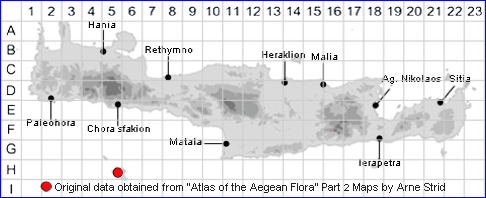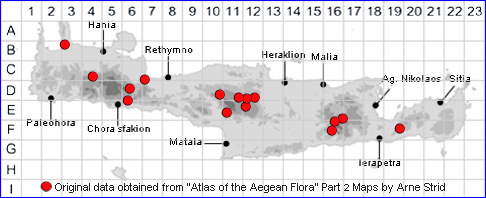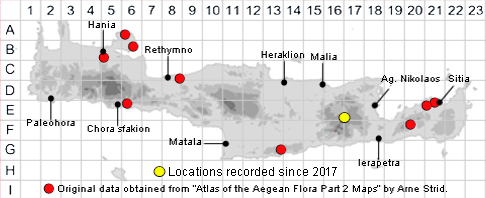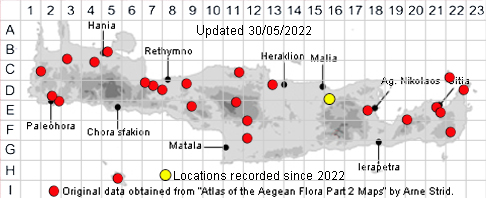
SPECIES DESCRIPTION
RUMEX PULCHER
Including: The following four subspecies
Family:- POLYGONACEAE/Subgen. RUMEX
Common Names:- None
Synonyms:- None
Meaning:- Rumex (L) A name used by the Roman naturalist and philosopher Pliny
for sorrel.
Pulcher (L) Rolled up, crowded.
General description:- Perennial, often papillose.
Stem:-
1) 20-60 cm tall
2) Usually single stemmed. 20-60 cm tall,
3) With stiff, ± divaricate branches.
Leaves:-
a) ovate-oblong.
b) often somewhat constricted at or below the middle. (panduriform)
c) subcordate to cordate at the base.
d) obtuse, flat or with slightly undulate margins.
2) Lower, blade, usually 4-9 cm.
3) Basal, small, fleshy.
Flowers:-
1) Inflorescence:
a) of several dense, remote whorls.
b) with leaf-like bracts in the lower part.
2) Pedicels short, usually thickened.
Fruit:-
1) Fruiting valves 4.5-6 x 2.5-4,5 mm of various shapes.
a) with a network of raised veins, all tuberculate.
Key features:-
1) Flowers in whorls of more than 4.
2) Pedicels equalling or shorter than the valves.
a) stout.
b) articulated near the middle
3) Leaves:
a) mostly less than 10 cm.
b) usually panduriform.
c) lower not more than 3½ times as long as wide.
4) Stems, branching strongly divaricate
Habitat:- Seasonally damp spots in scrubland vegetation, roadsides, olive groves,
rudral habitats. 0-800(-1500) m.
Distribution:- Throughout Greece. -Widespread in W Europe, the Mediterranean
region, Anatolia and Caucasus, naturalized in North America, Australia and
lsewhere; very variable.
Flowering time:- Apr-June.
Photos by:-
FAMILY AND GENUS DESCRIPTIONS
POLYGONACEAE
General description:- Herbs, shrubs or climbers.
Leaves:- Nearly always alternate; stipules often united to form a membranous
sheath (ochrea).
Flowers:- Hermaphrodite or unisexual; perianth 3- to 6-merous, herbaceous, often
enlarging and becoming membranous in fruit. Stamens usually 6-9. Ovary superior,
single celled (unilocular); styles 2-4; ovule solitary, basal.
Fruit:- An obtusely 3-angled (trigonous) or discoid with a convex lens-shape
(lenticular) nut.
RUMEX
General description:- Herbs, rarely shrubs, usually with long, stout roots,
sometimes rhizomatous.
Leaves:- Alternate; ochreae tubular.
Flowers:- Hermaphrodite or unisexual, arranged in whorls on simple or branched
inflorescences, wind-pollinated (anemophilous). Perianth-segments in 2 whorls of 3,
the outer remaining small and thin, the inner becoming enlarged and often hardened
in fruit. Valves (fruiting inner perianth-segments) sometimes developing marginal
teeth or dorsal tubercles as they mature. Stamens in 2 whorls of 3; anthers
attached to the filament by the base (basifixed).
Fruit:- A trigonous nut.
Key features:-
1) Stamens 6- 8.
2) Leaves at least 2 cm; not palmately lobed.
3) Flowers in panicles.
4) Stamens 8 or fewer.
5) Perianth-segments 6, the inner much larger than the outer in fruit.
Subgen. RUMEX
Leaves:- Basal and lower cauline never hastate or sagittate.
Flowers:- All or most hermaphrodite. Valves several times as wide as the nut, with
or without tubercles.
RUMEX PULCHER subsp ANODONTUS Back to Top
Synonyms:- None
Meaning:- Anodontus (Gr) With outward-pointing teeth.
Resembling Rumex pulcher, but differering in the following characters:
1) Basal leaves usually constricted at the mid-point.(panduriform).
2) Branches angular-flexuous, often forming an intricate mass.
3) Valves:
a) less than - 0.5 mm long.
b) subentire or with 1 or 2 basal spines up to 0·5 mm near the base.
c) 4-5 mm, narrowly ovate-triangular.
Habitat:- Seasonally damp spots in scrubland vegetation, roadsides, olive groves,
rudral habitats. 0-800(-1500) m.
Distribution:- Scattered in the Mediterranen region and SW Asia. Rare on Crete
known from only from the island of Gavdos.
Flowering time:- Apr-June.
RUMEX PULCHER subsp PULCHER Back to Top
Synonyms:- None
Meaning:- Pulcher (L) Rolled up, crowded.
Resembling Rumex pulcher, but differering in the following characters:
1) Basal leaves, usually oblong to elliptic but constricted at the mid-point.
(panduriform).
2) Branches angular-flexuous, often forming an intricate mass.
3) Valves entire at the apex.
3) Spines of the valves
a) 14 mm long.
b) usually 3-6 on each side.
c) 1-2 mm long.
Habitat:- Seasonally damp spots in scrubland vegetation, roadsides, olive groves,
rudral habitats. 0-800(-1500) m.
Distribution:- Scattered in the Mediterranen region and SW Asia. On Crete mainly
confinerd to the four main massifs.
Flowering time:- Apr-June.
RUMEX PULCHER subsp RAULINII Back to Top
Synonyms:- None
Meaning:- Raulinii (L) Probably for Victor Raulin, French Botanist (1819-1905)
Resembling Rumex pulcher, but differering in the following characters:
1) Basal leaves, usually oblong to elliptic but constricted at the mid-point.
(panduriform).
2) Branches angular-flexuous, often forming an intricate mass.
3) Valves entire at the apex.
3) Spines of the valves
a) 14 mm long.
b) usually 3-6 on each side.
c) 1-2 mm long.
Habitat:- Seasonally damp spots in scrubland vegetation, roadsides, olive groves,
rudral habitats. 0-800(-1500) m.
Distribution:- Mostly in the Aegean area, probably extending to Bulgaria and W
Anatolia. Rare on Crete known from only a few scattered locations.
Flowering time:- Apr-June.
Photos by:- Steve Lenton
RUMEX PULCHER subsp WOODSII Back to Top
Synonyms:-
Meaning:- Woodsii (L) For John Medley Wood (1827-1915) Curator of Durban
botanic Garden.
Resembling Rumex pulcher, but differering in the following characters:
1) Basal leaves, seldom constricted at the mid-point.(panduriform)..
2) Branches arcuate-divaricate.
3) Valves:
a) spines more than 0.5 mm long.
b) spines up to 8 on each side.
c) short and often irregular.
Habitat:- Seasonally damp spots in scrubland vegetation, roadsides, olive groves,
rudral habitats. 0-800(-1500) m.
Distribution:- Mostly in the Aegean area, probably extending to Bulgaria and W
Anatolia. Fairly rare on Crete known from only a few scattered locations.
Flowering time:- Apr-June.
Photos by:- Zacharias Angourakis



